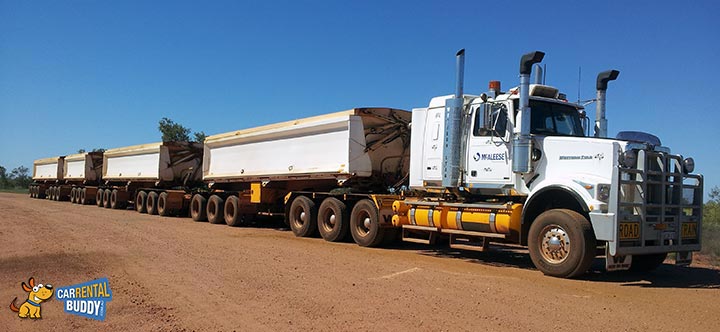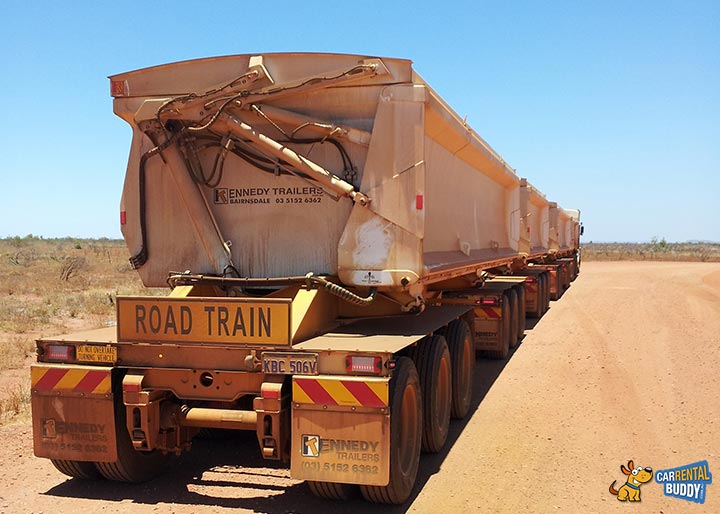Sharing the Road With Road Trains
What travels at 100 kilometres per hour, weighs approximately 170 tonne, is 53.5 metres long, has four trailers, and 86 tyres?
This is a key description of a quad road train that is a prominent mode of transport for the heavy haulage industries within Australia.

When travelling on certain roads within Australia, you will discover that you are sharing the road with a variety of heavy haulage vehicles that include single trailers, b-doubles, pocket road trains, b-triples, double road trains, triple road trains, and quad road trains.
We hope this article can assist drivers, especially international visitors, on key points for how to safely share the road with road trains and other heavy haulage vehicles.

Don't pull out in front of a road train - they are travelling at 100 kilometres per hour and their weight to stopping time ratio is not like a car. Best rule, if you are entering onto a road zoned at 100 kilometres per hour, do not pull out if the road train is within less than a kilometre of your position.

If you are travelling behind a road train and you wish to overtake, it is important to consider the actions you are going to take and determine whether it is safe to do so.
Road trains can be as long as 53.5 metres - be amazed but don't become nervous over the sheer size of a road train. Take this into consideration as well as the speed limit of the road you are travelling on. When overtaking, only move back into the left lane once you are able to clearly see both of the road train's headlights in your mirrors.
Once safely back in your lane, remember to keep a constant speed and don't slow down!
All too often, road train drivers comment that drivers overtake only to reduce their speed once in front which can cause accidents. Road train drivers do have the capability to overtake drivers, so if you have chosen to overtake a road train to be in front, then please don't reduce your speed below the signed speed limit as this will only result in the road train driver overtaking you!

When following a heavy haulage vehicle, you will generally find signage on the back of the trailer to advise of the vehicle's characteristics. This will assist with outlining whether extra care needs to be taken when overtaking.
For example, the image below illustrate that the vehicle is a road train. Road trains can be as long as 53.5 metres, so if you are planning on overtaking, you will need to keep this in mind to ensure you safely navigate your way in front of the road train.


If you need to pull off the road, give plenty of warning by indicating for at least 100 metres. This will provide the road train driver with enough time to start slowing his vehicle to allow you enough distance and time to pull off the road safely. Ensure your vehicle is completely off the road and there is enough room for you to open your driver door safely.

The same rule for navigating off the road applies for turning right - don't suddenly stop to make a turn. This is especially important on single lane roads where road trains have no position to manoeuvre around your suddenly stationary vehicle. Road trains do not go off road as this showers cars with rocks and the weight of vehicle can damage the edge of the road. If you suddenly stop, a road train can only impact with your vehicle!
If you miss a turn, keep going and look for a safe place to pull over to perform a u-turn.

Road trains are a large vehicle that will take the entire width of their lane. Ensure you are correctly positioned within your lane and that you are not travelling too close or on the middle white lines.
When travelling on unsealed roads, you will experience poor visibility with oncoming traffic due to dust. If a road train is approaching, it is recommended that you slow down and safely navigate far left as possible.

- Don't forget to put your headlights on in situations where visibility may be impaired.
- Use your hazard lights when in a situation that requires you to provide warning to fellow drivers.
- Don't tailgate a road train - keep your distance, especially on unsealed roads where poor visibility may be experienced.
- Don't overtake a turning vehicle - give plenty of room for road trains to navigate their right or left turn.
- Be patient, use common sense, and drive sensibly.
Keep the following safety tips in mind when travelling on Australian roads that are used by road trains and other heavy haulage vehicles and your driving experience will be a pleasurable one.
If you're looking for some great informative reading material to help you with your Australian travel adventures, then be sure to check out 'Lonely Planet Outback Australia Road Trips (Travel Guide)'.
Don't forget to take regular breaks and use common sense when driving to ensure your safety, the safety of your passengers, and fellow motorists.


 Peta Daniels is the managing director & owner of Car Rental Buddy & strives to present a comprehensive car hire comparison & booking website.
Peta Daniels is the managing director & owner of Car Rental Buddy & strives to present a comprehensive car hire comparison & booking website.